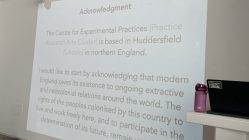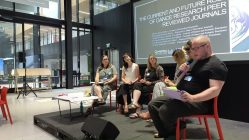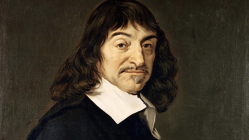Duration: 3:48
Project: Judaica
Song: Yafim Halelot
Practitioner: Ben Spatz
Director: Agnieszka Mendel
Videography: Nazlıhan Eda Erçin
Date: 11 May 2017
Venue: Centre for Psychophysical Performance Research
Source File: J016B
COMMENTARY
Ben
In this video, a contemporary political crisis is embodied through a conflict in the actor/director relationship. The song ‘Yafim Halelot’ is taken from the album Jewish Folk Songs, by Ruth Rubin. The lyrics are romantic and pastoral, as Ruth Rubin describes in the liner notes: ‘On a hillside, a shepherd guards his flock from marauding jackals.’ Yet Rubin adds another crucial piece of information: This song was ‘popular among early pioneers in Palestine.’ Agnieszka assigned this song to me, which I certainly would not have chosen for myself. Directing me in songwork, she no doubt expected me to explore its lyrical images, yet the song hit me from an entirely different angle.
The word ‘pioneers’ calls to mind the genocide of indigenous peoples in North America and the continuity of that settler colonialism with the founding of the state of Israel. Who were these ‘pioneers’ and from what historical perspective are they being called ‘early’? When Agnieszka reads the English translation out loud to me — ‘Lovely are the nights in Canaan’ — I imagine a crystalline desert night cut through by settler colonial violence. I have never been to Israel and can only imagine how the layers of history intersect in bodies there. I imagine myself as a settler, enjoying the night air but always fearful that those whom I have dispossessed will return to take back their land. Later I imagine myself part of the resistance, captured and imprisoned by the state. When I watch the video excerpt, I think about how often this kind of actor/director conflict occurs in theatrical processes but does not make it to the public stage. What are we missing when we exclude these kinds of problematic moments from our performances?
Eda
This is one of the first footages recorded by me in which I find the courage and need to get closer to the practitioner at moments of explicit intensity. At this stage in the process, I am not well-informed about the multilayered cultural context which the song brings into the space. Ben is engaging with a cultural and aesthetic territory which is in one sense unfamiliar to me in relation to the language, melody, rhythm and meaning of the song. In another sense, I am very close to this song geographically, more than my two fellow practitioners. Ben’s hands are up at the back of his head clamped together; he inconsistently rocks back and forth as if he’s trying to keep his balance and find a way to engage with the song. He sings as if he is in pain. What makes him sing this song in this particular way, I wonder and I get closer and closer to him with the intention of finding an answer to my inner question. His eyes are closed; his voice is cracking temporarily but loud and articulate. Then I startle when Agnieszka begins to recite the English translation of the song as a poem. At that moment, I am very close to Ben’s face and I clearly see that something is changing as Agnieszka continues to read the poem. Ben stops. He unties his hands, releases one of them, the other one still at the back of his head, he gently opens his eyes and stares at the floor. Something blocks him, he can barely sing it with a deep breathy voice. I stay still and stay close in that moment of ‘change in direction’ with an urge to understand what it is that is happening right now.
Agnieszka
This session was for me the first big astonishment in the studio-work within the Judaica Project.
At the end of the previous week Ben gave us a task that the next set of songs that we are going to learn will be chosen by a partner, so Eda was supposed to select a song for me, Ben for Eda and I was to pick a song for Ben. I chose ‘Yafim Halelot’. There were two reasons. First was that I liked the melody and wanted it to be present in the territory of our work, and if I was not given the task to assign a song to a partner I would learn it myself. Second, thinking about Ben, I intended to find a song that would resonate with a peaceful message and energy. That was because in the previous stage we had just worked on ‘Chad Gadya’ — on the surface seeming to be an entertaining story —telling for children, in fact deeply allegorical, multilayered testimony of ‘oppression and retribution in Jewish history from ancient days to the present’ (liner notes, Chad Gadya). The ‘Chad Gadya’ song, funny as well as vicious, a chain story of one little goat that is eaten by a cat that is bitten by a dog that is hit by a stick that is burnt by fire that is quenched by water that is drunk by an ox that is slaughtered by a butcher that is killed by the Angel of Death that is annihilated by God — in my imagination already brought a huge spiral of symbolic violence into the space (although narrated with great humor) and I urged for an essential antitype.
‘Yafim Halelot’ draws an idyllic landscape – a balanced symbiosis – of the innocent, not penetrated nature and a sweetheart affection of two – supposedly young and innocent too – lovers:
Lovely are the nights in Canaan, silent and crystal clear.
The stillness seems to sing, my heart replies with a song.
Come to me Rachel, my love!
— liner notes, Jewish Folk Songs
That was the contrast I needed. Naively I assumed that the song will direct the practitioner towards my associations automatically. It did not happen that way. And at that moment I did not understand the contesting interpretation of Ben’s enactment.







[…] 11 May 2017 conflicting associations 2 […]
[…] often approach studio practice as preparation for death or for imprisonment. Of course this has to be done with care. We have to be careful not to use our knowledge of the […]